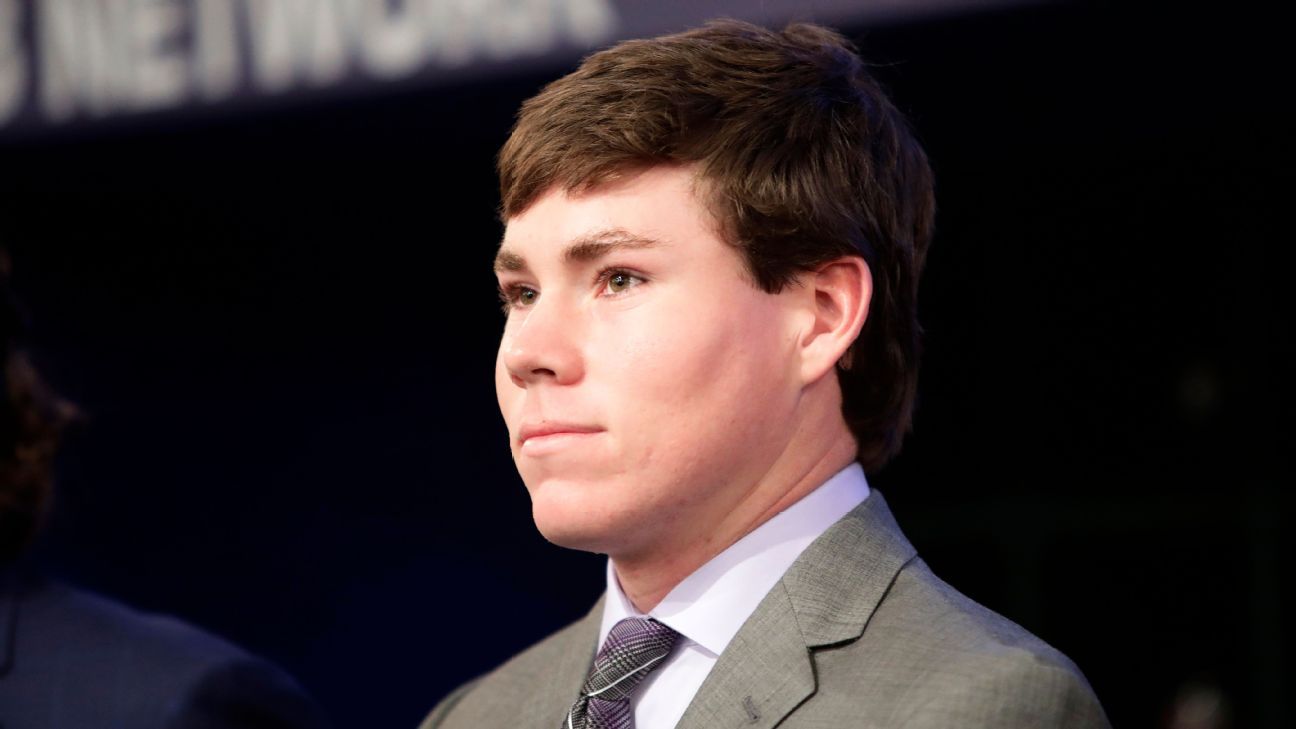For years, opponents of Major League Baseball’s draft who believed it stifled the true value of players have hypothesized about ways to avoid its constraints. Nineteen-year-old Carter Stewart is ready to test the viability of an alternative — and travel more than 7,500 miles from his Florida home to do it.
Stewart is in agreement on a six-year contract worth more than $7 million with the Fukuoka SoftBank Hawks of Japan’s Pacific League, sources familiar with the deal told ESPN. Stewart was the No. 8 overall pick in last year’s MLB draft but didn’t sign after the Atlanta Braves, who believed he was injured, offered him a signing bonus well under the $4.98 million slot value of the pick — around $2 million. Stewart went to junior college instead and was expected to go early in the second round of this year’s draft — and receive an offer of less than $2 million.
Instead, he agreed to a groundbreaking contract with the Hawks, who have won four of the past five Japan Series. Stewart is expected to finalize the deal by the end of May. Not only does Stewart stand to make more money during his six years in Japan than he would have with an MLB organization, he could potentially return to the United States as a 25-year-old free agent allowed to sign a long-term contract with any of MLB’s 30 teams.
Certainly that is a long way from today, when Stewart is a raw right-handed pitcher with a mid-90s fastball and a curveball that last year flashed elite spin, whirring at more than 3,000 rpm. Still, the value proposition of playing in Japan was alluring enough to convince Stewart to play patient zero and make real what long has been a what-if question bandied about baseball.
The idea of a player decamping to Japan has been floated over the years by agent Scott Boras, who represents Stewart, in an attempt to extract leverage in an amateur draft system without any. Every team is assigned a pool of money to divvy up in signing bonuses, and teams are penalized for exceeding that pool. The rules have essentially capped draft spending.
Stewart’s decision makes easy sense financially. Say he stayed in the United States and signed for $2 million. Best case, Stewart would have started with a team’s short-season Class A affiliate. In 2020, he would top out at Double-A and make less than $10,000 for the season. And if Stewart is that good, and moving that quickly, his team probably would keep him at scant wages in the minor leagues for all of 2021, too, and promote him around this time in 2022 to ensure it controls him for 6¾ years before free agency. In 2022, 2023 and 2024, Stewart would make the major league minimum — which, being generous and assuming the new collective bargaining agreement gives it a big bump, could be $750,000.
In a near-optimal scenario, Stewart would receive around $4 million for the next six years — and would not reach free agency until after the 2027 season, when he will be 28. His deal with the Hawks would guarantee Stewart $3 million more and potentially allow him to hit free agency three years earlier.
MLB’s rules require a “foreign professional” to have spent “all or part of at least six seasons” playing in an “MLB-recognized foreign professional league.” Even though Stewart is American, sources told ESPN that residency determination for foreign players is based on a number of factors, including where a player has played, where he plans to live, as well as his nationality. Stewart, under current rules, would be considered a foreign professional if he spends the next six seasons in Japan, sources said, though those rules are subject to change.
If they do not, Stewart could at age 25 join MLB via the posting system, which is used to transfer players between the leagues. The system allows foreign professionals 25 and older unrestricted free agency and delivers a fee to their Japanese team that depends upon the size of the contract negotiated with the MLB team.
All of this, of course, is wildly presumptuous. Stewart is 19 years old. He could get hurt. He could lose control of his pitches. He could regress. Pitching prospects are notoriously finicky, and ascribing to him an idealized scenario isn’t entirely fair.
It’s just a function of the draft’s clamping down on players’ value for so long. The reason teams place such a premium on draft picks is because the assets gained with those picks carry enormous marginal value. Were Adley Rutschman, the switch-hitting Oregon State catcher widely expected to go No. 1 overall on June 3, a completely unrestricted free agent, teams would line up to pay him at least $50 million — perhaps upward of $75 million. The slot value of the Baltimore Orioles‘ No. 1 pick is $8,415,300.
It’s no wonder, then, that Boras wants to subvert the draft. For more than 30 years, he has raged against it, whether it was through Tim Belcher not signing in 1983 or Brien Taylor squeezing a record bonus out of the New York Yankees in 1991 or Jason Varitek and J.D. Drew going to independent leagues or the loophole that made four draft picks unrestricted free agents in 1996. This is not so much a loophole as it is an end around — and one with risk.
Stewart, after all, is a kid from the Space Coast who played baseball at Eau Gallie High School last year and Eastern Florida State College this season. The baseball culture in Japan is markedly different from that of the major leagues, let alone the travel league, high school and juco ball Stewart has played. The Japanese minor leagues, or ni-gun, are even more trying. All of Stewart’s physical skills will require complementary mental toughness. On the other hand, the competition will be plenty representative, and by the time he does arrive in the Japanese major leagues, he’ll be playing in the finest foreign league on the planet, the best training ground possible for MLB.
If Stewart excels, it could change baseball. Not only is the money better, the marketing opportunities in Japan for baseball players far exceed those in the United States. Other amateur talent could follow — or at least use the possibility of Japan as a cudgel, potentially forcing MLB to reassess its draft rules. In a tweet more than five years ago, Hiroshi Mikitani, the billionaire owner of the Tohoku Rakuten Golden Eagles, said he hoped Nippon Professional Baseball would loosen restrictions on foreign players, which currently limit each team to four. Perhaps Japanese teams could start recruiting more amateurs in the Dominican Republic, an area MLB monopolizes.
The fact that it took decades for a player like Stewart to agree to such a deal might indicate this is more the exception than the rule. Most 19-year-olds aren’t altogether keen on going to a country in which they don’t speak the language, learning new customs and figuring out how to thrive in a game as difficult as baseball. Then again, kids from the Dominican Republic and Venezuela and Colombia and all around Latin America do it every day in MLB — and for far less than the millions Stewart will receive.
Stewart, in the end, is a proxy for something bigger — a haymaker at a system capable of careening out of control until brought back into balance. Perhaps Stewart is that counterweight. Maybe it’s someone after him. Could be that nothing changes and this is but a blip. Whatever the case, it’s a noble effort, an admirable risk and a fascinating story, this idea in a vacuum coming to life and playing out 60 feet, 6 inches from home plate and thousands and thousands of miles from home.

